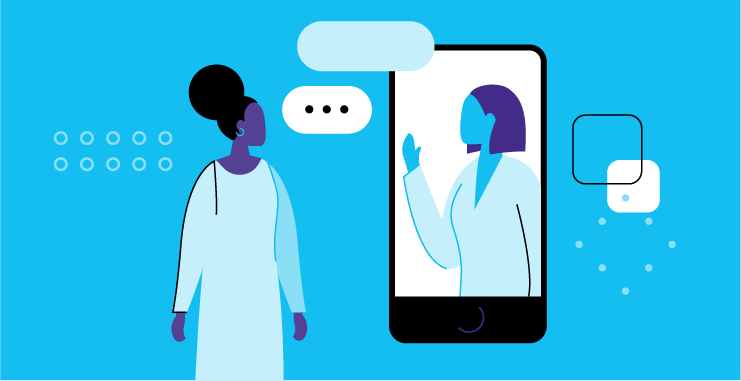


Telehealth and Telemedicine, often used interchangeably, have become synonymous with healthcare services during the ongoing Covid-19 pandemic. Telemedicine, that was historically considered less viable as it faced adoption barriers from providers, patients, and payers alike, has undergone a massive expansion over the last year-and-a-half. One study comparing health insurance claims for telemedicine reported an increase from a mean of 773 visits per week pre-pandemic to 45,632 visits weekly post-pandemic.
During a time when healthcare systems were facing enormous patient volumes with a high risk of Covid-19 transmission, telemedicine expanded from being accessible to 1 percent of the US rural population in 2019 to 158% increased usage in 2020. This unprecedented growth in Telemedicine services and usage is a result of regulatory authorities, physicians, hospital systems and patients embracing the need for safe and efficient care. On January 31, 2020, United States declared public health emergency (PHE), which authorised Centers for Medicare and Medicaid Services (CMS), the country’s leading healthcare regulatory body to issue blanket waivers and flexibilities to hospitals, other healthcare facilities including nursing homes and skilled nursing facilities, physicians and non-physician practitioners and state Medicaid agencies.
Also Read: Of Vaccines, Data, And The Future: A Perspective On COVID-19 Pandemic
These waivers enabled a range of providers, such as doctors, nurse practitioners and licensed clinical social workers, to offer telehealth across the country including at patient’s residence while ensuring Medicare payments for telehealth visits like in-person visits. Regulatory waivers and facilitation lead to several downstream effects in patient care like protecting high-risk and elderly residents, health care workers from unnecessary exposure to Covid-19, early discharge from hospitalisation followed by remote patient monitoring and preventing outbreaks of infection in post-acute congruent living facilities such as assisted living centers and sub-acute rehabilitation centers.
Telehealth became a valuable tool for “forward triaging” where patients are sorted prior to arrival in emergency rooms thereby avoiding new hospital visits and freeing up hospital beds and equipment for patients who need them the most. At New York University’s Langone Health, which was well prepared to expand telecare, Virtual Urgent care visits grew by 683% and non-urgent doctor visits grew by 4,345% over a period of six weeks by April 2020. For patients admitted in critical care units, it allowed intensive care specialists to step in and assist facilities overwhelmed by the pandemic. Telehealth aims to increase access to quality healthcare to vulnerable populations, including individuals in rural and remote areas, providing a more affordable, inclusive, and convenient healthcare.
Telehealth found its niche among emerging digitally enabled developing countries such as India with care providers, technology providers witnessing up to nine times surge in physician consults, with close to 80% first time patients seeking care by June 2020. With availability of 6.8 ICU beds per 100,000 people and less than 5,000 intensivists, Tele-ICU expanded the reach of remote critical care delivery during the pandemic. Tele-medicine clinics brought specialist care to small towns and remote villages, upgrading the local doctor’s office, and supplementing primary health centers (PHC). Technology, internet, and mobile telephony have been great levelers in the previous two decades. It has provided access and opportunities to a generation of people who lacked any such openings or avenues in the past. Telemedicine along with payment interfaces like mobile payments apps like “BHIM” (Bharat Interface for Money, a UPI enabled initiative to facilitate safe, easy & instant digital payments) have changed not only delivery of the care but also how India pays for the healthcare services.
Over the past few decades, the world has faced three named pandemics with a fourth one currently ongoing and an increased risk of future pandemics. The development and utilisation of telemedicine and telehealth will continue to provide high-quality, increasingly accessible, and equitable healthcare while maintaining a surge capacity when need arises to supplement in-person care. It has potential to reduce healthcare costs, improve patient outcomes and outreach.
With chronic disease set to affect an estimated 157 million people in the US alone, physicians can use telehealth to better manage their patients, improve efficiency, improve compliance with regular follow-ups and reduce no-shows. It has increased convenience, increased access to care in remote locations and made available specialists in resource-scarce areas. For developing countries like India, technological infrastructure such as internet connectivity, technical staff members, digitisation of medical records and navigating patient-provider confidentiality are key to make Telehealth services merge into mainstream tiered health care systems.
The gains made in Telehealth and Telemedicine during this pandemic have the potential to revolutionise healthcare delivery and coverage with proper expansion, regulatory support, and increased infrastructure support to end the digital divide which often plagues accessibility. Uneven healthcare regulations, provider credentialing requirements, reimbursement barriers and payer adoption had made it difficult to adopt this technology in the past.
Waivers have been able to temporarily remove the proverbial red tape but without legislation and a path to unification, the exponential growth may just flatline. Ethical concerns, Health Insurance Portability and Accountability Act, data privacy and technological deserts are the domains which need to be redefined for this aspect of health care.
A sustainable, patient centered and accessible model for Telehealth and Telemedicine will increase mainstream usage and help us prepare for a more equitable future of healthcare.
(Sanghavi & Misra are MD at Mayo Clinic)
[Disclaimer: The opinions, beliefs, and views expressed by various authors and forum participants on this website are personal.]